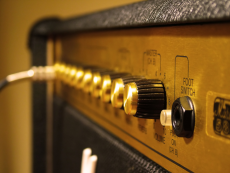
In the first article on guitar amplification, I focussed on the key features of guitar amplification and how the parts come together to make an overall sound. In this article, I will be focussing more on specific variables and effects used in guitar amplification.
There are controls for you to manipulate on both the body of the guitar and on the amp itself, as well as effects pedals, which can be added via the amp and have controls of their own. Each of these adds up to give the final overall effect on the guitar sound.
Beginning with the controls on the guitar, there are several basic controls to change. Firstly, on some guitars you have the option to adjust the equalisation levels. This relates to how much bass, middle and treble can be heard from the guitar input. By turning up the bass and minimising the treble, only the lowest parts of the notes will come through, creating a very different tone to that when the treble is turned up and the bass reduced. When deciding on equalisation settings, you really just have to play around with it to get the sound you want for that particular performance and how you’ll want it to sound will differ between different genres and on different guitars. You can also set the volume from the guitar, as well as some settings specific to individual guitars, such as fullness of the sound. Certain guitars also include a whammy bar or tremolo. This is pressed down to bend the pitch of the note being played up and down rhythmically, a technique used in certain genres of music such as rock. From the guitar you can also choose which pick-ups you want to use on the guitar. Pick-ups are the microphones on the guitar. There are ones at various places at the end of the neck and which ones are used will make the guitar sound different. Some will give a warmer sound, while some will sound more metallic. You can also use a mixture of several pick-ups.
On the amplifier you can also change the equalisation and the volume. Since these controls are often found on the amp and on the guitar itself, you will get a slightly different sound when you turn the volume up on the amp and down on the guitar from when you have it up on the guitar and down on the amp, so it’s worth trying different settings until you find one you really like. On the amp, you’ll generally also find clean and lead channels. Plugging the guitar into the clean input will give you a simpler sound that tends to be used for rock and roll or country music, while the Lead input is generally used to get a muddier and fuller sound, more like that used in modern rock or pop music.
Effects pedals can also be added to the guitar sound through effects loops, though these can be a little more complicated. When the pedals are depressed, the effect is added to the sound. This allows guitarists to add effects to the guitar sound for only passages or sections of the song, or just specific songs in a set. Effects pedals can add many different things to the sound. Tremolo pedals have the same effect as a tremolo bar on the body of the guitar, but there are many more, each with their own distinct properties. These include overdrive, wah-wah, chorus and phaser pedals to name just of the few of the most famous. However, I will delve more closely into these specifically in my next article on guitar effects.
Image from: http://www.musicfutures.com/wp-content/uploads/2015/03/Top-3-Best-Guitar-Amps-Under-1000.jpg

0 Comment:
Be the first one to comment on this article.